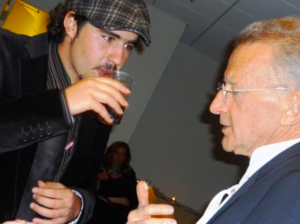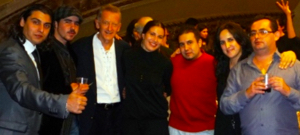Fuego Flamenco IV
November/December 2008 By Ken McNaughton

I arrived half an hour before show time on Friday 21 November, put my jacket on a seat in the second row, returned to the lobby and sipped a decaf as the crowd arrived. In particular I watched the movements of two women, one of whom had the tightly drawn face of a dancer. One time when they were conversing nearby I overheard her mention The Washington Post. The lobby lights flickered and I made my way back to the theatre, only to find I was sitting next to her and her companion, Karen. We chatted before the show and she referred to something she had written.
The show was called “Ida y Vuelta” and was performed by a group from the Fundación Conservatorio Flamenco, an incubator for new creative talent at Casa Patas, a world-renowned tablao in Madrid. “Ida y vuelta” means departure and return, or round trip, a term sometimes applied to the way music is exported, influenced, and comes back changed. Guadalupe Torres is director, choreographer and dancer; Luís Miguel Manzano is musical director and guitarist. El Trini de la Isla and José Anilla do the singing and palmas. The real surprise is Diego Villegas Gómez, who plays flute, harmonica and saxophone and blends into the flamenco in a very natural and elevating way. The most satisfying dances were the duets between Gaudalupe and José Maldonado, whom I affectionately dubbed “Baby Face.”
There was a reception after the show with food supplied by Rumberos, an adjacent restaurant, and drinks by Osborne Solaz Wines. I got chatting with a young man who used his excellent Spanish to ask José Maldonado, on my behalf, how old he was—only 23! The vigorous footwork of a male flamenco dancer is ideally suited to the young but, as we would see later in the festival, a female flamenco dancer can still wow us later in her life.
The cast made a beautiful, gracious presence at the reception. There seemed no awkward barriers of language or separation between performers and audience. I got chatting to Diego (Fig. 1), whose English was better than my Spanish, and I congratulated him on his creative contributions. He was keen to see the review from The Washington Post, which my new friend Paula Durbin would be working on over the weekend. She and Karen also made good companions at the reception and we found our impressions of the performance quite similar.
Begoña Fernández Pellicer, a representative of Casa Patas (literally “the House of Feet”), was taking photos and surrendered her camera so she could be photographed with some of the cast. Diego urged me into the photograph and I found myself wedged between him and the lovely Guadalupe (Fig. 2). When I forwarded Paula’s review to Diego, I asked him to remind Begoña to send me the photos, which she did.

On Saturday 29 November I was back at the Gala to attend “Flamenco en Familia,” a workshop led by Edwin Aparicio, our local flamenco dancer phenomenon. In the audience there were a lot of Hispanic families with young children. On stage were a lot of my friends—Miguel Pérez on guitar, Behzad Habibzai on cajón, and Carlton Ashton on singing and palmas. Dancers included Sara Jerez Marlow, María, Defne Enc Lujan and Genoveva, who assisted Edwin in leading the workshop from 11 a.m. to 1 p.m. They demonstrated many basic dance moves and called volunteers from the audience on stage to learn a couple of routines. My professional friends lined up in the wings to watch and I gained a renewed appreciation for all they have achieved when I tried to copy the movements. My favorite rhythm is the rumba and I have achieved a certain notoriety for my creative freestyle, but when I tried to copy Genoveva's compas—clap, clap, clap, stomp; clap, clap, clap, stomp—I found even that hard to maintain.
Outside the theatre it was nice to get a few words with Sara and we exchanged our latest news before she and María slipped off to Starbucks to relax prior to a repeat workshop from 2 to 4 p.m. Sara asked if I was going to stick around, but I said I was going home for lunch; best leave the professional work to the pros and keep my amateur status.
On Sunday 7 December I attended the final performance of the Festival—a new work by the Flamenco Aparicio Dance Company called “Dos Mundos,” which refers to the two worlds of traditional and modern flamenco styles. This was a large company, including many of my friends—Richard Marlow on guitar, Behzad again on percussion, and Bernard “Jason” Vera-y-Aragón the lone male dancer. The star of the show was La Tati, a veteran from Madrid who brought three musicians with her—a guitarist and two singer/palmists.
The rest of the corps included three principal female dancers—locals Genoveva and Anna Menéndez, and Defne, who is visiting from Spain; all three changed colorful costumes. They were supported by nine other dancers, many of whom I knew. They captured my attention immediately with a sensational opening. Lines of dancers criss-crossed the stage in boot-cut black jeans and black tops, flamenco foot-tapping in mechanical robot succession. It was exciting to see such progressive ideas alongside traditional forms. La Tati wowed us with her energy and creativity, at one time coming on stage with a walking cane and using that in conjunction with dazzling footwork and non-stop eye-catching moves and humor.
COPYRIGHT
This work is copyrighted and may not be reproduced in whole or in part in any medium without written permission from Ken McNaughton Living Trust, 3778 College Avenue, Ellicott City, MD 21043; phone/fax: 410-418-9340; kjmcn@comcast.net (1 June 2015). Photos courtesy of Art Soiree. Photos of dancing motion in fading light are difficult.



